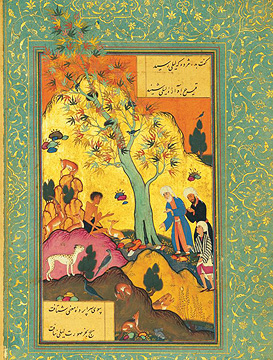Image Resource Bank
Image Gallery |  9 of 15
9 of 15 
Majnun in the Wilderness
Majnun and Layla represent the classical tragic lovers in the classical Middle East tradition, and have been compared to Romeo and Juliet in the later world of Shakespeare. A young Bedouin poet named Qays, said to have lived at the time of Muhammad, falls in love with Layla (also spelled Leyla or Leyli), yet is denied permission to marry her and goes mad from longing. He is known as “Majnun Layla,” literally “Mad for Layla,” or “Crazed for Layla.” The word majnun originally meant “possessed by jinn,” (genies, jinnis), those semi-spiritual beings that were associated with love, madness, and poetry. Majnun goes to live in the wilderness wearing only a loincloth and sees Layla everywhere, addressing the rocks, stones, and animals with her name. He ultimately perishes out of his infinite longing for her. Sufi poets would expand on the themes of the story, having the character of Majnun represent mystical love for God that leads to annihilation of the ego-self in union with the divine beloved. After the 10th century, Arab authors began to collected love-lyrics (ghazals) attributed to Majnun and embed them in a romantic narrative. Poets soon began to sing the legend of Majnun and Layla in longer epics. Nezami (d. 1209 CE) and Jami (d. 1492 CE) composed the two most famous versions in Persian. An English translation of the Nezami’s Majnun and Layla helped inspire Eric Clapton’s 1975 classic album entitled Layla.
Name: Majnun in the Wilderness
Material: Ink and paint on paper
Size: Unknown
Date: 1507 CE
Place of Origin: Tabriz, Iran
Location: Tehran Museum of Contemporary Art
Source and Registration#:
Wikimedia![]() , (accessed February 5, 2010).
, (accessed February 5, 2010).

 Michael Sells
Michael Sells
John Henry Barrows Professor of Islamic History and Literature, Divinity School, The University of Chicago




